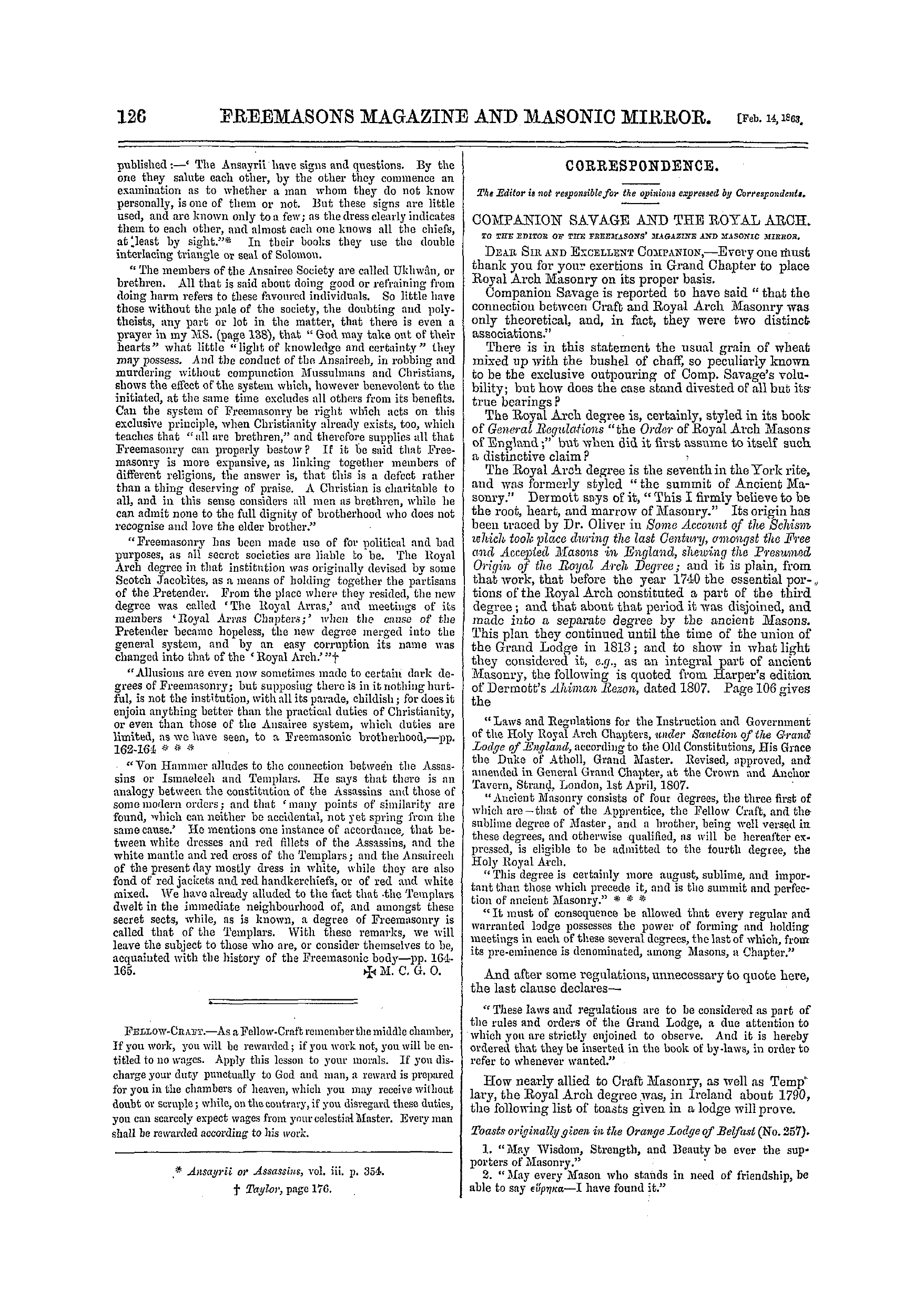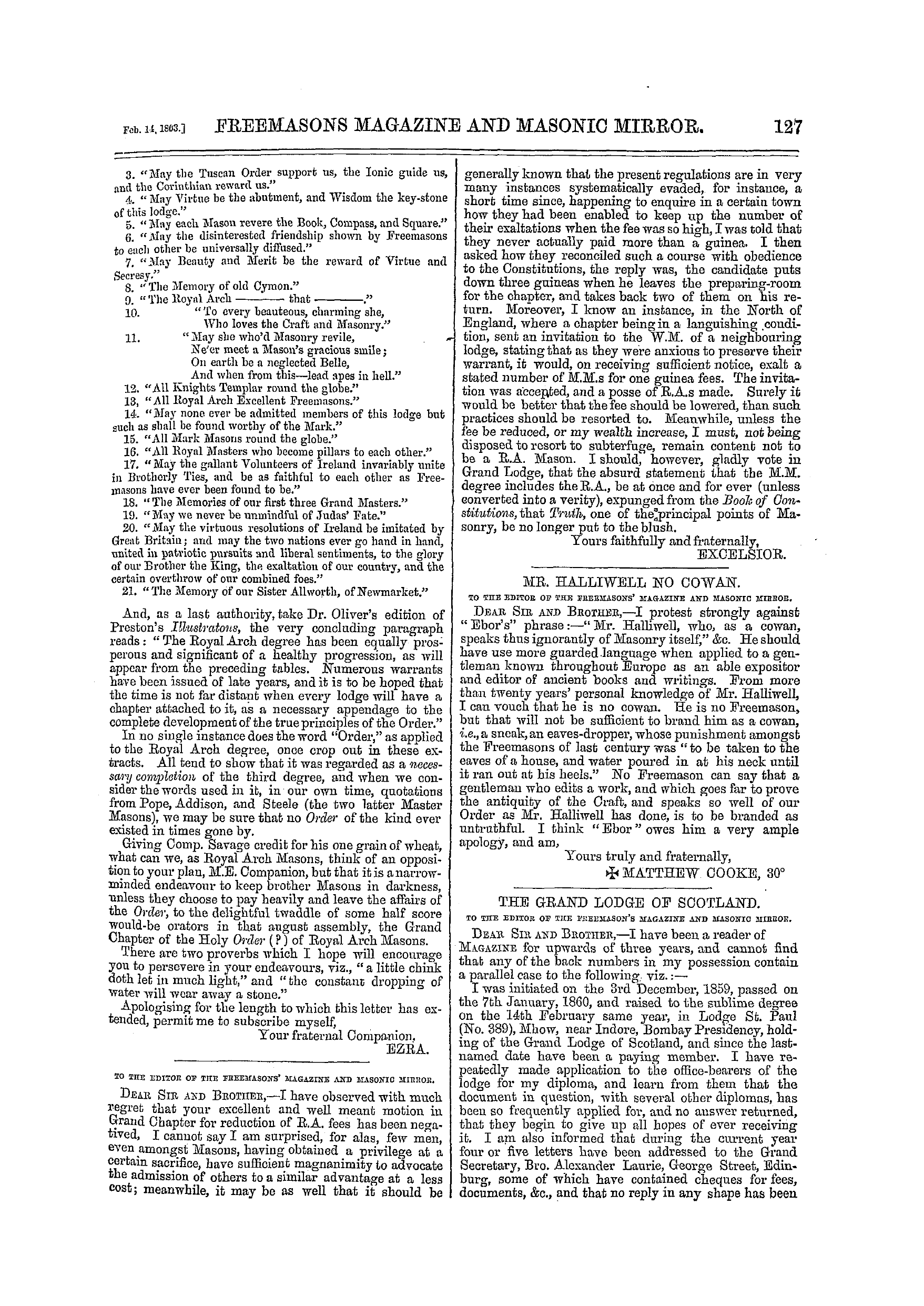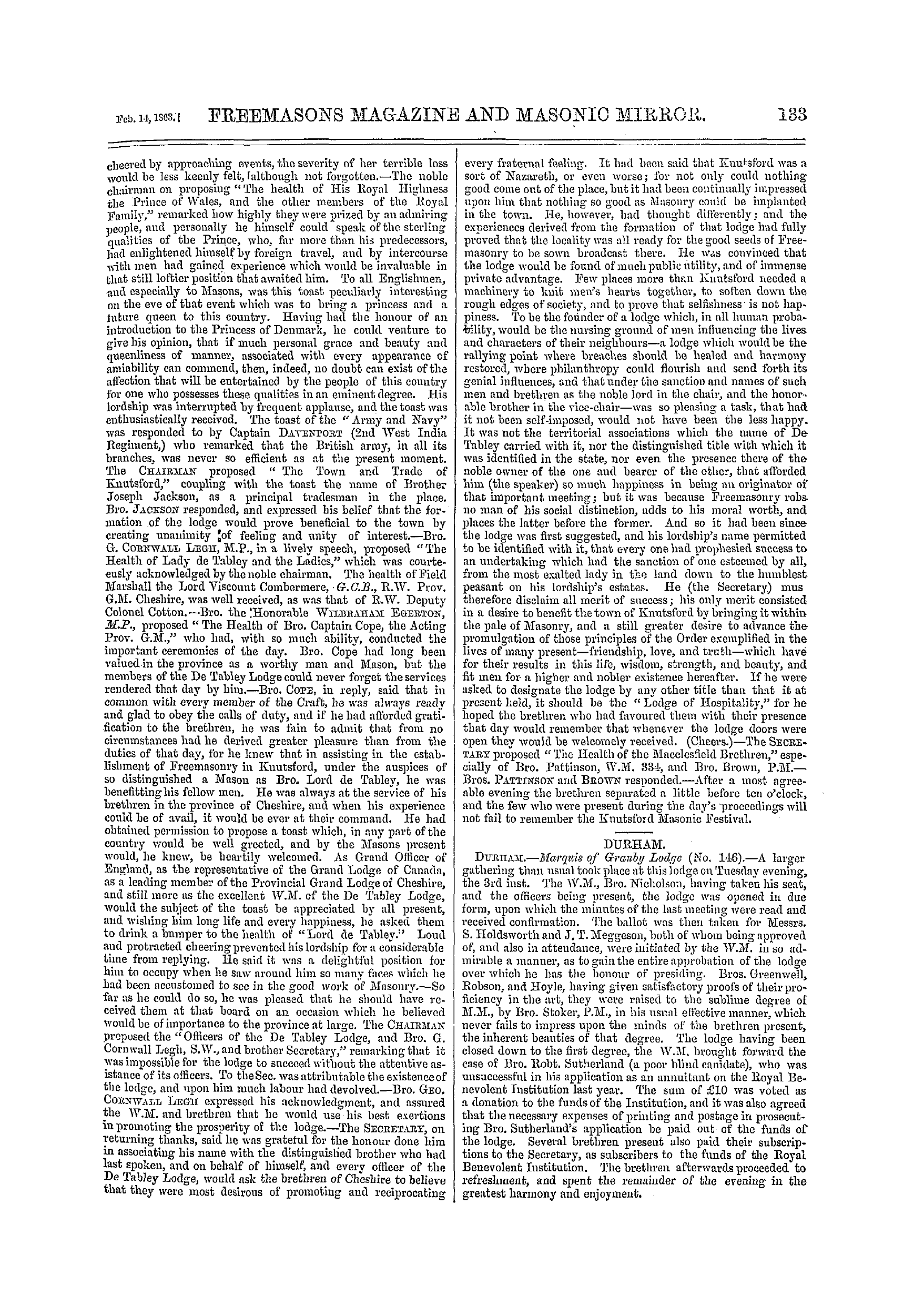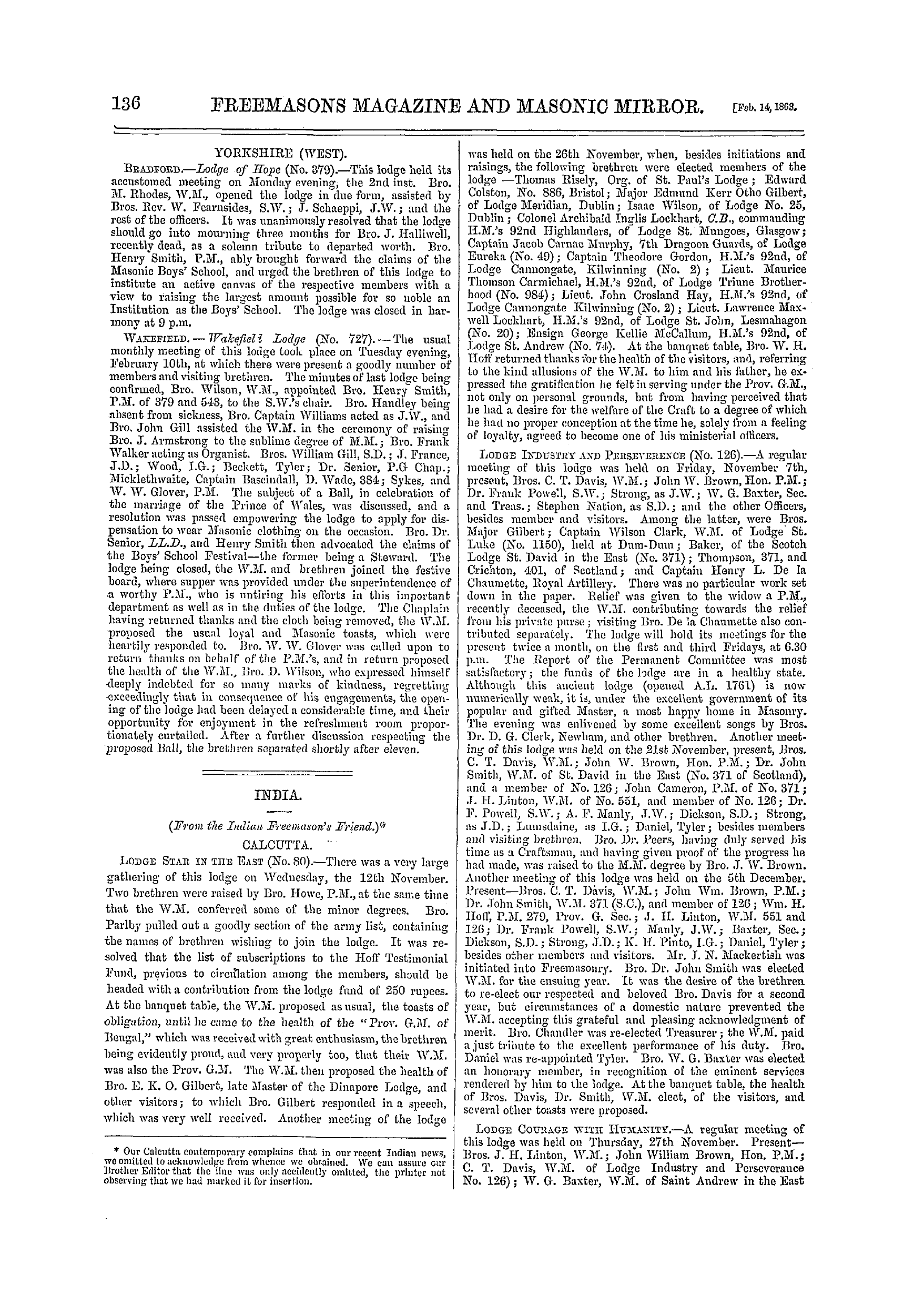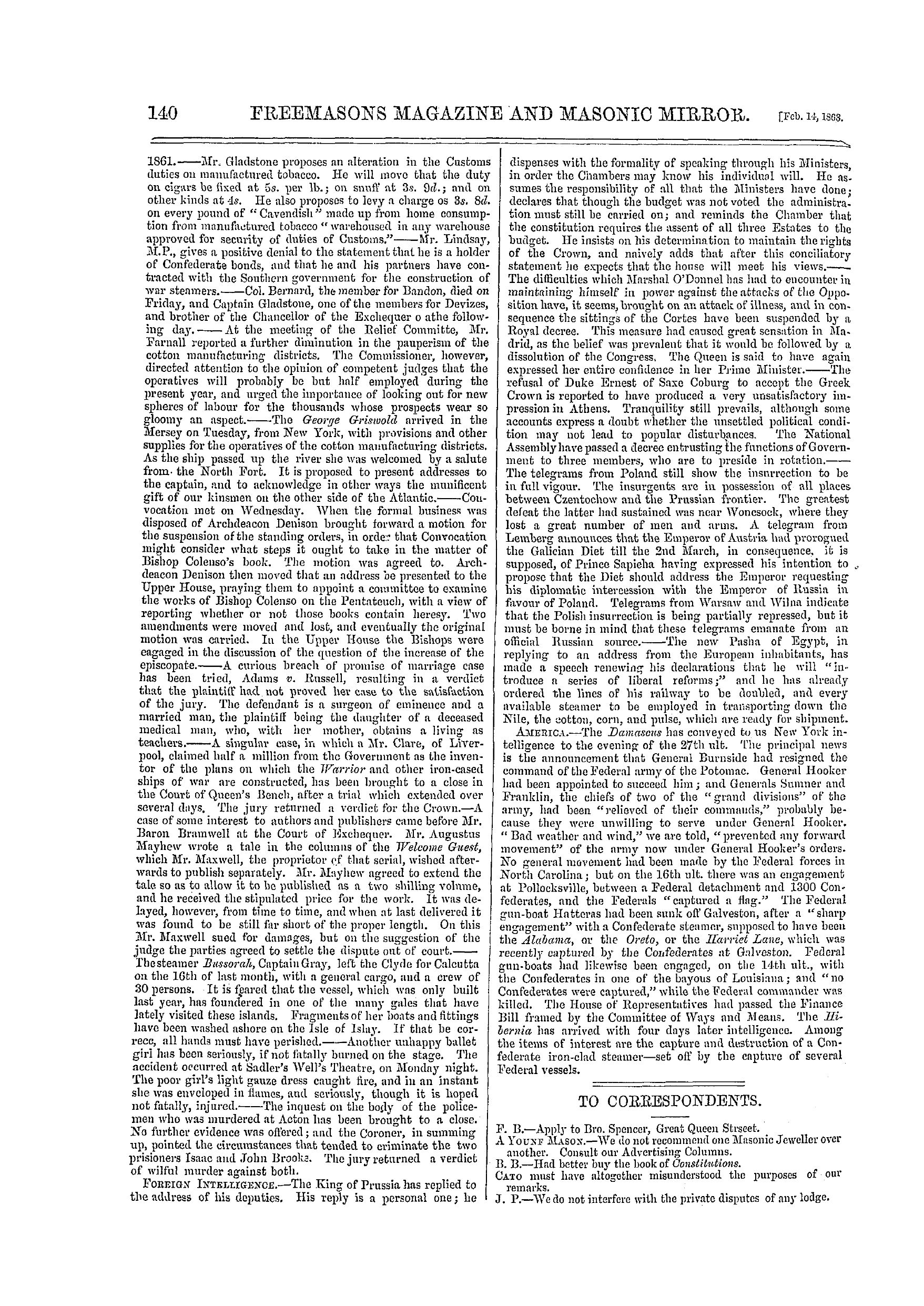-
Articles/Ads
Article MASONIC NOTES AND QUERIES. ← Page 4 of 4 Article CORRESPONDENCE. Page 1 of 2 →
Note: This text has been automatically extracted via Optical Character Recognition (OCR) software.
Masonic Notes And Queries.
published : — ' The Ansayrii have signs and questions . By the one they salute each other , by the other they commence an examination as to Avhether a man whom they do not know personally , is one of them or not . But these signs are little used , aud are known only to a few ; as the dress clearly indicates them to each other , and almost each one knows all the chiefs , at'least by sight . " * In their hooks they use the double interlacing triangle or seal of Solomon .
" The members of the Ansairee Society are called tfkhwan , or brethren . All that is said about doing good or refraining from doing harm refers to these favoured individuals . So little have those ivitbout the pale of the society , the doubting and polytheists , any part or lot in the matter , that there is even a prayer in my MS . ( page 138 ) , that " God may take out of their hearts" what little "light of knowledge and certainty" they may possess . And the conduct of the Ansaireeh , in robbing and
murdering without compunction Mussulmans and Christians , shows the effect of the system which , however benevolent to the initiated , at the same time excludes all others from its benefits . Can the system of Freemasonry be right which acts on this exclusive principle , when Christianity already exists , too , which teaches that "all are brethren , " and therefore supplies all that Freemasonry can properly bestow ? If it be said that Freemasonry is more expansiveas linking together members of
, different religions , the answer is , that this is a defect rather than a thing deserving of praise . A Christian is charitable to all , and in this sense considers all men as brethren , while he can admit none to the full dignity of brotherhood who does not recognise and love the elder brother . "
"Freemasonry has been made use of for political and bad purposes , as all secret societies are liable bo be . The Royal Arch degree in that institution was originally devised by some Scotch Jacobites , as a means of holding together the partisans of the Pretender . From the place where they resided , the new degree was called 'The Royal Arras / and meetings of its members 'Koyal Arras Chapters ; ' when the cause of the Pretender became hopeless , the new degree merged into the
general system , and by an easy corruption its name was changed into that of the ' Royal Arch . ' "f "Allusions are even now sometimes made to certain dark degrees of Freemasonry ; but supposing there is in it nothing hurtful , is not the institution , with all its parade , childish ; for does it enjoin anything better than the practical duties of Christianity , or even than those of the Ansairee system , which duties are limited , as we have seen , to a Freemasonic brotherhood , —pp . 162-164 * * *
" Von Hammer alludes to the connection between the Assassins or Ismaeleeh and Templars . He says that there is an analogy between the constitution of the Assassins and those of some modern orders ; and that ' many points of similarity are found , which can neither be accidental , not yet spring from the same cause / He mentions one instance of accordance , that between white dresses and red fillets of the Assassins , and the white mantle and red cross of the Templars ; and the Ansaireeh
of the present day mostly dress in white , while they are also fond of red jackets and red handkerchiefs , or of red and white mixed . We have already alluded to the fact that -the Templars dwelt in the immediate neighbourhood of , and amongst these secret sects , while , as is known , a degree of Freemasonry is called that of the Templars . With these remarks , Ave will leave the subject to those who are , or consider themselves to be , acquainted with the history of the Freemasonic body—pp . 164-165 . > J < M . C . G . 0 .
FBILOAA ' -CE AIT . —As a Fellow-Craft remember the middle chamber , If you work , you will be rewarded ; if you work not , you will he entitled to no wages . Apply this lesson to your morals . If you discharge your duty punctually to God and man , a reward is prepared for you in the chambers of heaven , which you may receive without
doubt ov scruple ; while , on the contrary , if you disregard these duties , you can scarcely expect wages from your celestial Master . Every man shall be rewarded according to his work .
Correspondence.
CORRESPONDENCE .
The Editor is not responsible for the opinions expressed by Correspondents , COMPANION SAVAGE AND THE ROYAL ARCH . TO THE EDITOK OF THE FREEMASONS' MAGAZINE AND MASONIC HIItSOB . DEAR SIR AND EXCELLENT CoirpANTON , —Every one must thank you for your exertions in Grand Chapter to place Royal Arch Masonry on its proper basis .
Companion SaA-age is reported to have said " that the connection between Craft and Royal Arch Masonry was only theoretical , and , in fact , they were two distinct associations . " There is in this statement the usual grain of wheat mixed up Avith the bushel of chaff , so peculiarly known to be the exclusive outpouring of Comp . Savage ' s
volubility ; but hoAv does the case stand divested of all but its true bearings ? The Royal Arch degree is , certainly , styled in its book of General Regulations "the Order of Royal Arch Masons of England ; " but when did it first assume to it-self such , a distinctive claim ? > The Royal Arch degree is the seventh in the York rite ,
and AA as formerly styled " the summit of Ancient Masonry . " Dermott says of it , " This I firmly believe to be the root , heart , and marroAv of Masonry . " Its origin has been traced by Dr . Oliver iu Some Account of the Schism which tooh place during the last Century , amongst the Free and Aerated Masons in England , shelving the Presumed Origin of the Eoyal Arch Degree ; and it is plain , from
that Avork , that before the year 1740 the essential portions of the Royal Arch constituted a part of the third degree -, and that about that period it Avas disjoined , and made into a separate degree by the ancient Masons . This plan they continued until the time of the union of the Grand Lodge in 1813 ; and to shoAV in what light they considered it , e . g ., as an integral part of ancient Masonry , the folloAving is quoted from Harper ' s edition of Dermott ' s Ahiman Rezon , dated 1807 . Page 106 gives the
" Laws and Regulations for the Instruction and Government of the Holy Royal Arch Chapters , under Sanction of tlie Grand Lodge of England , according to the Old Constitutions , His Grace the Duke of Atholl , Grand Master . Revised , approved , and amended in General Grand Chapter , at the Crown and Anchor Tavern , Strand , London , 1 st April , 1807 . "Ancient Masonry consists of four degrees , the three first of which are—that of the Apprentice , the Fellow Craft , and the
sublime degree of Master , and a brother , being well versed in these degrees , and otherwise qualified , as will be hereafter expressed , is eligible to he admitted to the fourth degree , the Holy Royal Arch . " This degree is certainly more august , sublime , and important than those which precede it , and is the summit and perfection of ancient Masonry . " * * * " It must of consequence be allowed that every regular and warranted lodge possesses the power of forming and holding meetings in each of these several degrees , the last of which , from its pre-eminence is denominated , among Masons , a Chapter . "
And after some regulations , unnecessary to quote here , the last clause declares" These laws and regulations are to be considered as part of the rules and orders of the Grand Lodge , a due attention to which you are strictly enjoined to observe . And it is hereby ordered that they be inserted in the book of by-laws , in order to refer to whenever wanted . "
How nearly allied to Craft Masonry , as well as Temp " lary , the Royal Arch degree was , in Ireland about 1790 , the folloAving list of toasts given in a lodge will prove . Toasts originally given in the Orange Lodge of Belfast ( No . 257 ) . 1 . " May AVisdom , Strength , and Beauty be ever the supporters of Masonry . " 2 . " May every Mason who stands in need of friendship , be able to say eSp-nica—I have found it . "
Note: This text has been automatically extracted via Optical Character Recognition (OCR) software.
Masonic Notes And Queries.
published : — ' The Ansayrii have signs and questions . By the one they salute each other , by the other they commence an examination as to Avhether a man whom they do not know personally , is one of them or not . But these signs are little used , aud are known only to a few ; as the dress clearly indicates them to each other , and almost each one knows all the chiefs , at'least by sight . " * In their hooks they use the double interlacing triangle or seal of Solomon .
" The members of the Ansairee Society are called tfkhwan , or brethren . All that is said about doing good or refraining from doing harm refers to these favoured individuals . So little have those ivitbout the pale of the society , the doubting and polytheists , any part or lot in the matter , that there is even a prayer in my MS . ( page 138 ) , that " God may take out of their hearts" what little "light of knowledge and certainty" they may possess . And the conduct of the Ansaireeh , in robbing and
murdering without compunction Mussulmans and Christians , shows the effect of the system which , however benevolent to the initiated , at the same time excludes all others from its benefits . Can the system of Freemasonry be right which acts on this exclusive principle , when Christianity already exists , too , which teaches that "all are brethren , " and therefore supplies all that Freemasonry can properly bestow ? If it be said that Freemasonry is more expansiveas linking together members of
, different religions , the answer is , that this is a defect rather than a thing deserving of praise . A Christian is charitable to all , and in this sense considers all men as brethren , while he can admit none to the full dignity of brotherhood who does not recognise and love the elder brother . "
"Freemasonry has been made use of for political and bad purposes , as all secret societies are liable bo be . The Royal Arch degree in that institution was originally devised by some Scotch Jacobites , as a means of holding together the partisans of the Pretender . From the place where they resided , the new degree was called 'The Royal Arras / and meetings of its members 'Koyal Arras Chapters ; ' when the cause of the Pretender became hopeless , the new degree merged into the
general system , and by an easy corruption its name was changed into that of the ' Royal Arch . ' "f "Allusions are even now sometimes made to certain dark degrees of Freemasonry ; but supposing there is in it nothing hurtful , is not the institution , with all its parade , childish ; for does it enjoin anything better than the practical duties of Christianity , or even than those of the Ansairee system , which duties are limited , as we have seen , to a Freemasonic brotherhood , —pp . 162-164 * * *
" Von Hammer alludes to the connection between the Assassins or Ismaeleeh and Templars . He says that there is an analogy between the constitution of the Assassins and those of some modern orders ; and that ' many points of similarity are found , which can neither be accidental , not yet spring from the same cause / He mentions one instance of accordance , that between white dresses and red fillets of the Assassins , and the white mantle and red cross of the Templars ; and the Ansaireeh
of the present day mostly dress in white , while they are also fond of red jackets and red handkerchiefs , or of red and white mixed . We have already alluded to the fact that -the Templars dwelt in the immediate neighbourhood of , and amongst these secret sects , while , as is known , a degree of Freemasonry is called that of the Templars . With these remarks , Ave will leave the subject to those who are , or consider themselves to be , acquainted with the history of the Freemasonic body—pp . 164-165 . > J < M . C . G . 0 .
FBILOAA ' -CE AIT . —As a Fellow-Craft remember the middle chamber , If you work , you will be rewarded ; if you work not , you will he entitled to no wages . Apply this lesson to your morals . If you discharge your duty punctually to God and man , a reward is prepared for you in the chambers of heaven , which you may receive without
doubt ov scruple ; while , on the contrary , if you disregard these duties , you can scarcely expect wages from your celestial Master . Every man shall be rewarded according to his work .
Correspondence.
CORRESPONDENCE .
The Editor is not responsible for the opinions expressed by Correspondents , COMPANION SAVAGE AND THE ROYAL ARCH . TO THE EDITOK OF THE FREEMASONS' MAGAZINE AND MASONIC HIItSOB . DEAR SIR AND EXCELLENT CoirpANTON , —Every one must thank you for your exertions in Grand Chapter to place Royal Arch Masonry on its proper basis .
Companion SaA-age is reported to have said " that the connection between Craft and Royal Arch Masonry was only theoretical , and , in fact , they were two distinct associations . " There is in this statement the usual grain of wheat mixed up Avith the bushel of chaff , so peculiarly known to be the exclusive outpouring of Comp . Savage ' s
volubility ; but hoAv does the case stand divested of all but its true bearings ? The Royal Arch degree is , certainly , styled in its book of General Regulations "the Order of Royal Arch Masons of England ; " but when did it first assume to it-self such , a distinctive claim ? > The Royal Arch degree is the seventh in the York rite ,
and AA as formerly styled " the summit of Ancient Masonry . " Dermott says of it , " This I firmly believe to be the root , heart , and marroAv of Masonry . " Its origin has been traced by Dr . Oliver iu Some Account of the Schism which tooh place during the last Century , amongst the Free and Aerated Masons in England , shelving the Presumed Origin of the Eoyal Arch Degree ; and it is plain , from
that Avork , that before the year 1740 the essential portions of the Royal Arch constituted a part of the third degree -, and that about that period it Avas disjoined , and made into a separate degree by the ancient Masons . This plan they continued until the time of the union of the Grand Lodge in 1813 ; and to shoAV in what light they considered it , e . g ., as an integral part of ancient Masonry , the folloAving is quoted from Harper ' s edition of Dermott ' s Ahiman Rezon , dated 1807 . Page 106 gives the
" Laws and Regulations for the Instruction and Government of the Holy Royal Arch Chapters , under Sanction of tlie Grand Lodge of England , according to the Old Constitutions , His Grace the Duke of Atholl , Grand Master . Revised , approved , and amended in General Grand Chapter , at the Crown and Anchor Tavern , Strand , London , 1 st April , 1807 . "Ancient Masonry consists of four degrees , the three first of which are—that of the Apprentice , the Fellow Craft , and the
sublime degree of Master , and a brother , being well versed in these degrees , and otherwise qualified , as will be hereafter expressed , is eligible to he admitted to the fourth degree , the Holy Royal Arch . " This degree is certainly more august , sublime , and important than those which precede it , and is the summit and perfection of ancient Masonry . " * * * " It must of consequence be allowed that every regular and warranted lodge possesses the power of forming and holding meetings in each of these several degrees , the last of which , from its pre-eminence is denominated , among Masons , a Chapter . "
And after some regulations , unnecessary to quote here , the last clause declares" These laws and regulations are to be considered as part of the rules and orders of the Grand Lodge , a due attention to which you are strictly enjoined to observe . And it is hereby ordered that they be inserted in the book of by-laws , in order to refer to whenever wanted . "
How nearly allied to Craft Masonry , as well as Temp " lary , the Royal Arch degree was , in Ireland about 1790 , the folloAving list of toasts given in a lodge will prove . Toasts originally given in the Orange Lodge of Belfast ( No . 257 ) . 1 . " May AVisdom , Strength , and Beauty be ever the supporters of Masonry . " 2 . " May every Mason who stands in need of friendship , be able to say eSp-nica—I have found it . "







